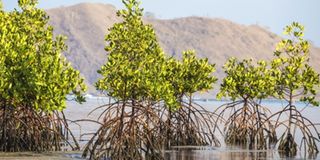Managing mangrove forests for nature and community benefits

Mangroves
What you need to know:
- Mangroves are one of the most productive ecosystems on earth and a renewable natural resource.
As we prepare to mark the International Day of Forests 2025, it is important that we reflect on mangrove forests, their multiple benefits, threats facing them, and how we could sustainably manage these critical ecosystems for nature and community benefits.
Mangroves are vital but fragile coastal wetlands found in intertidal areas of tropical coasts around the world. They are one of the most productive ecosystems on earth and a renewable natural resource.
In Kenya, mangrove forests cover an area of 61,000ha; providing livelihood to millions of people. Mangroves fulfil important functions in terms of providing wood and non-wood forest products, coastal protection and conservation of biological diversity as well as provision of habitat, spawning grounds, and nutrients for a variety of fish and shellfish.
They provide nutritional inputs to nearshore marine ecosystems that constitute the primary habitat, spawning and breeding grounds for many aquatic species of commercial importance. However, in Kenya, mangrove forests are greatly threatened by mainly unsustainable human use of its resources, pollution and natural causes, including climatic change.
But all is not lost.
The Kenya Marine and Fisheries Research Institute is partnering with government agencies, Lamu County Government and residents in a project aimed at strengthening local level governance of mangrove resources in the country.
The project’s objectives are to update data and information on mangrove forests in Lamu, build a national mangrove portal, establish a blue carbon offset facility, and restore at least 50 hectares of degraded mangroves through community participation. The project is funded by The Nature Conservancy and European Union’s Go Blue project through the United Nations Environment Programme.
Blue carbon markets
Blue carbon projects are initiatives that restore and protect coastal wetlands such as mangroves, seagrass beds and salt marshes. A groundbreaking blue carbon project in Lamu has engaged the local community in mangrove conservation activities, with the absorbed carbon dioxide by mangrove trees converted to carbon credits for sale in global market.
Lamu’s blue carbon projects are building on the success of smaller projects like Mikoko Pamoja and Vanga Blue Forest, both in Kwale County, that have demonstrated the effectiveness of community-led mangrove conservation approaches through carbon trading.
Lamu County is home to more than 60 per cent of mangroves in Kenya. These forests contribute to the livelihoods and economy of Lamu people through trade in mangrove wood products, fisheries support, coastal defence, and ecotourism activities.
The blue carbon project is expected to sequester 70,000 tonnes of carbon dioxide, thus generating Sh120 ¬million per year.
Beyond climate benefits, the project aims to protect the flagile mangrove biodiversity and provide valuable ecosystem services, aligning with the global Biodiversity Biodiversity Framework of living in harmony with nature by 2050; as well as the global sustainable goals (SDGs), particularly; SDG 13 (climate actions) and SDG 14 (live below water).
Dr Kairo is a chief scientist at the Kenya Marine and Fisheries Research Institute, and an international consultant in Mangrove Management


